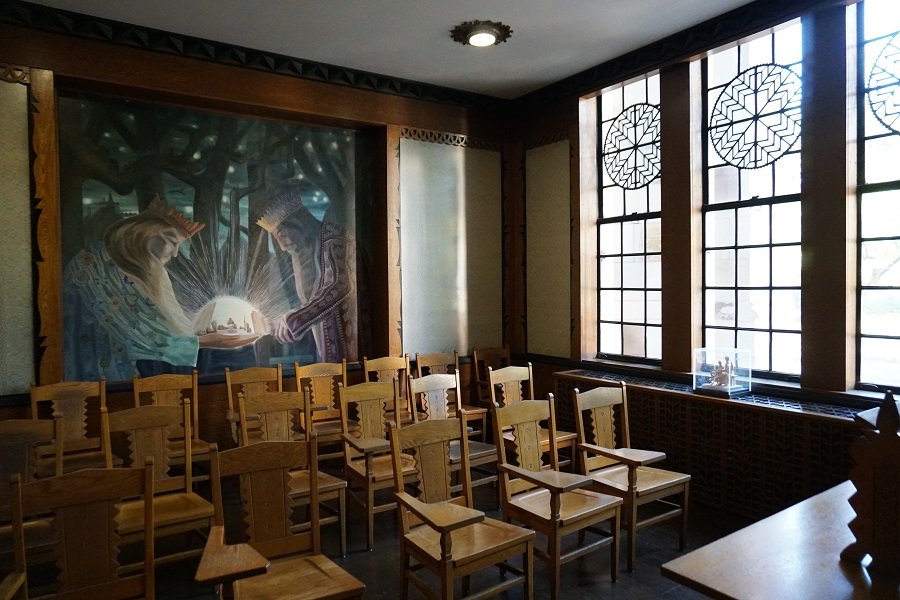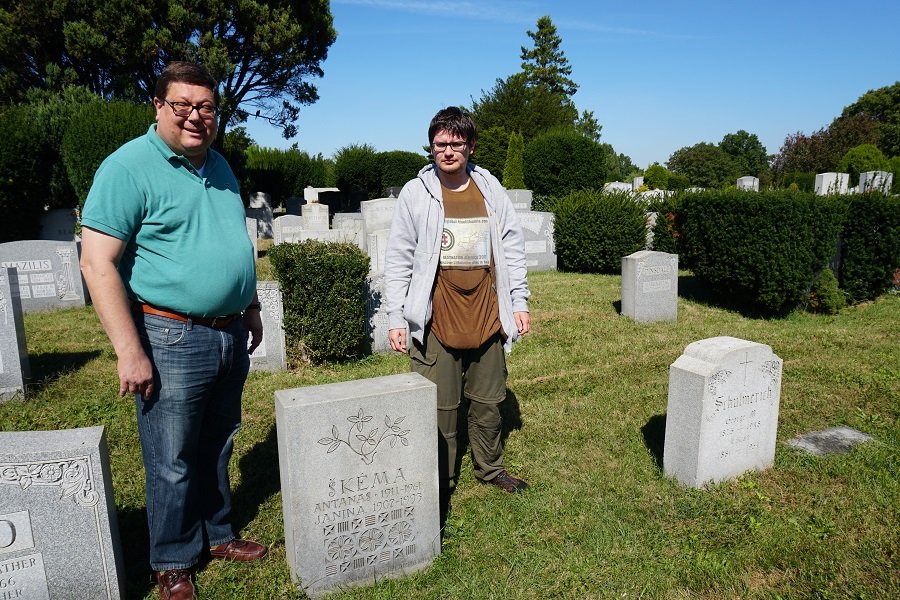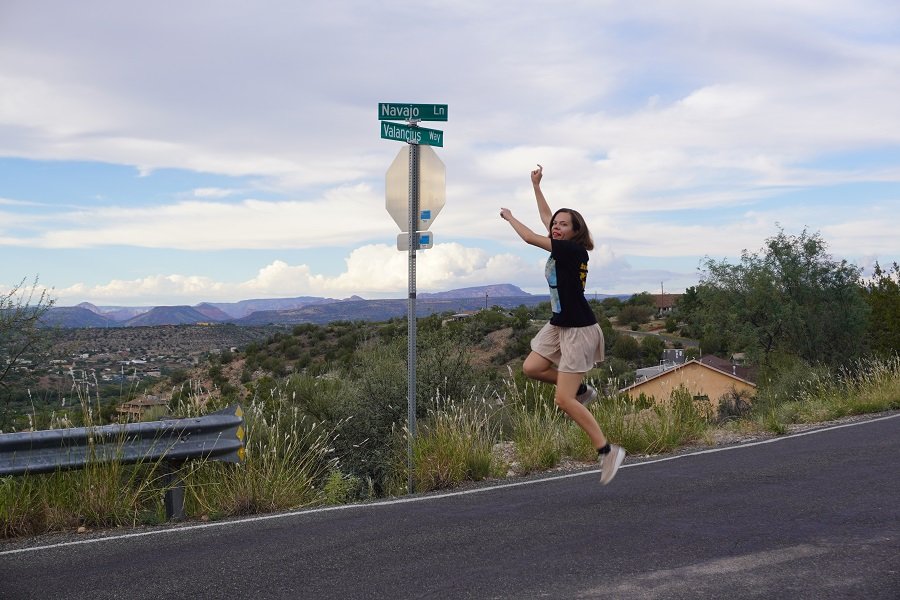
The 5-year long mapping mission came to an end: “Destination Lithuanian America “map of Lithuanian-American heritage now covers the entire USA, and it is accessible to everyone for free at http://map.truelithuania.com .
The final major expansion of the map was completed in 2022 January. Some 100 new Lithuanian heritage sites were added, increasing the total number to 750. The map covers Lithuanian-American churches, cemeteries, club buildings, monuments, museums, famous burials and more.
Every one of these additional sites was visited in person by the author of the map Augustinas Žemaitis, who also took images and recorded their stories. In addition, most of the information is available on the map’s sister website , as well as “True Lithuania “Youtube channel and “True Lithuania “Facebook.
Here some highlights of what is included in the “Destination Lithuanian America “map:
Lithuanian heritage of the towns and villages of the Pennsylvania coal region
In Pennsylvania Coal Region alone, as many as 105 Lithuanian heritage sites were added to the map.
This was the first area where Lithuanians settled in considerable numbers in the USA, starting in 1869 and numbering over 100 000 at the turn of the century. In this area alone, there are more than 40 Lithuanian churches, with a density of a Lithuanian church every 10 miles in some places, with one in almost every town.

Many of the Lithuanian parishes also had their cemeteries, and there are non-religious Lithuanian cemeteries as well. For example, the “capital “of Lithuanian heritage in the area Shenandoah town alone has 6 Lithuanian cemeteries. To this day, Shenandoah has some 12% of its population considering themselves Lithuanians. The Schuylkill County, where Shenandoah is located, some 5% makes it the most Lithuanian county in the USA. Each of the region’s Lithuanian churches (including the closed and/or demolished ones) and cemeteries are marked on the “Destination Lithuanian America “map while their stories and images are available on global.truelithuania.com .
Other sites, such as the Lithuanian club buildings (six of them still in operation), grand Lithuanian school buildings, and more, have also been painstakingly researched and mapped. Shenandoah, once known as “Vilnius of America “, is also important for the history of entire Lithuania: it was there, at a location also included in the “Destination Lithuanian America “map, where the world’s first Lithuanian-language novel was published (in 1904), at the time when Lithuanian language was still banned in Lithuania itself.
While the Pennsylvania Coal Region was the most Lithuanian area of the east coast, similar patterns of Lithuanian churches, Lithuanian cemeteries, Lithuanian parish schools have emerged all over the New England, Mid-Atlantic, and beyond (Pittsburgh area (PA), Merrimack Valley (MA/NH), New York City area (NY/NJ), Boston area (MA), towns of Connecticut, southern Illinois, etc.). Each of these places has also been thoroughly mapped. For a descendent of Lithuanian-Americans whose forefathers once lived in these so-called “Lithuanian colonies “, the map offers an excellent opportunity to easily discover the places where they prayed and performed religious rites, likely went for Lithuanian activities, and where their relatives are buried.
Buildings of the modern Lithuanian architectural style in America
The map also includes the world’s best buildings and monuments of the Modern Lithuanian architectural style that had been invented by Lithuanian-American architects in the 1950s-1960s.
At the time, Lithuania was occupied by the Soviet Union. Any ethnic architecture in Lithuania was replaced by drab Soviet styles, the same all over the Union. Most Lithuanian architects who built pre-WW2 independent Lithuania were either killed, expelled, or fled the country. Lithuanians who successfully fled to the USA aimed to create “pieces of Lithuania “there in the form of Lithuanian churches, monuments and club palaces.
For them, merely Lithuanian activities were not enough as they sought those to take place inside truly ethnic architecture as well. Lithuanian-American architects answered the call by reinterpreting traditional Lithuanian folk crafts on a monumental scale, using modern materials (e.g. building concrete church towers in the form of Lithuanian wooden chapel-posts) and using lots of Lithuanian symbols. Such ethnic modern architecture was unheard of even in the USA, where the “international style “prevailed at the time. Thus, the “Modern Lithuanian “style attracted American attention and prizes for its architects.
Indeed, this style is an important part of both the Lithuanian architectural history and a testament to the US acceptance of these Lithuanian immigrants, allowing them to continue cherishing their culture. Every building of the Modern Lithuanian style is included in “Destination Lithuanian America “, ranging from Chicago’s Nativity BVM church and the Lithuanian Youth Center, to the Lithuanian churches of East St. Louis (IL) and Queens (NY), to a massive memorial for those who died for Lithuania in Kennebunk, Maine.
Famous Lithuanian burials
The “Destination Lithuanian America “map includes 44 graves of the famous Lithuanian historical figures who are buried in the USA and Canada. Most of them fled the Soviet Genocide in 1944. As Soviets generally targetted the intellectuals, the “cream of the society “emigrated, many of them important politicians and artists who continued to create while in America. Some of these people are known to nearly every Lithuanian, yet their graves are somewhat forgotten because they are so far away from Lithuania. Now, every one of them had its location marked on the “Destination Lithuanian America “map, in addition to the luminaries of earlier Lithuanian waves of immigration to the USA. Among those whose burials are marked are:
General Povilas Plechavičius, who thwarted the Nazi plans to create a Lithuanian SS legion.
Writer Antanas Škėma, whose existentialist semi-autobiographical “White Shroud “is about an underemployed Lithuanian-American refugee in NYC, is considered the most important Lithuanian literary work of the century.

Among the other mapped burials is the “father of Lithuanian basketball “Pranas Lubinas / Frank Lubin, poet Henrikas Radauskas, world boxing champion Jack Sharkey (Juozapas Žukauskas), tennis player Vitas Gerulaitis, Hollywood star Charles Bronson (Karolis Bučinskis), world-famous archbishop Paul Marcinkus, and more.
Also included is the grave of the non-Lithuanian American Samuel Harris, who is known to be the only American soldier who died for Lithuania. He was shot by communists while lecturing the young Lithuanian armed forces in Kaunas in 1920, and now lies in Arlington, Virginia, where Lithuanians built a memorial for him with a Vytis bas-relief.
Lithuanian monuments in the USA
“Destination Lithuanian America “map includes 179 memorials and commemorative plaques in the USA, ranging from “Monuments to those who died to Lithuanian freedom “to statues of particular famous Lithuanians and Lithuanian-Americans to public plaques describing the history of the local Lithuanian communities. These have been erected from Yorktown, Texas (where the oldest known Lithuanian community of America exists, dating to 1850s) to Springfield, IL and Shenandoah, PA.
For much of the 20th century, Lithuanian monuments could not have been constructed in Lithuania itself as it was occupied. Nevertheless, Lithuanian-Americans compensated by erecting many of them, especially ones dedicated to Lithuanians who fell for their country. For example, the world’s first monument to Romas Kalanta, who self-immolated against the Soviet regime, is located in Chicago.

America also became a treasure trove of Lithuanian ethnic artworks, such as UNESCO-World-Heritage-inscribed large Lithuanian wooden crosses that also incorporate the pagan sun symbolism. Each of these large crosses or similar ethnic monuments is also included in the “Destination Lithuanian America “map, as well as two entire “Hills of Crosses “in Lemont (IL), Camp Dainava (MI), and Missisauga (ON), both inspired by the original Hill of Crosses in Šiauliai.
111 Lithuanian heritage sites in Chicagoland
Chicagoland is the largest treasure trove of Lithuanian heritage sites in America, with as many as 111 of them added to the map.
This is not strange because Chicago is known as the “capital of Lithuanian diaspora “. Before World War 1, there were more Lithuanians in Chicago (by number) than in any city of still-rural Lithuania itself. Until the 1980s, Lithuanian mass was celebrated in more churches in Chicago than in Lithuania itself. Each of the churches in Chicago – just like all over the USA – were (and many of them still are) hubs of the secular Lithuanian culture as well, providing space for Lithuanian origanizations, dance groups, etc.

Each of these Chicago’s Lithuanian churches (demolished by now) has been added to the “Destination Lithuanian America “map. In the map, they are joined by the massive parish schools, Chicago’s Lithuanian clubs, two massive Lithuanian cemeteries full of Lithuanian monuments, famous burials, ethnic gravestones, and far more.
The authors of the map spent several weeks in Chicago in total in order to visit, photograph and research every site.
Lithuanian club palaces, often older than the Republic of Lithuania itself
Lithuanian immigration to America began in the 19th century when Lithuania was still deep in the discriminatory Russian Imperial rule that banned the Lithuanian language and culture there.
Lithuanians managed to build Lithuanian-symbol inscribed buildings and interiors in America long before they could have appeared in Lithuania itself. Furthermore, these buildings did not suffer Soviet occupation and thus were not demolished or gutted, unlike Lithuania’s “patriotic architecture”.

Among those “as old as the Republic of Lithuania “Lithuanian Halls included in the “Destination Lithuanian America “map, there is the Philadelphia’s Lithuanian Music Hall (1908), Grand Rapid’s Vytautas Aid Society (1910), Baltimore Lithuanian Hall (1920), and more. Each of those is still in operation, but those closed are included, as they often have Lithuanian inscriptions on their facades.
Localities named after Lithuania
“Destination Lithuanian America “includes 54 localities named after Lithuania or Lithuanians, including entire districts of Lithuanian streets in Lawrence (MA) and Nashua (NH), Lithuanian-named lakes Dainava and Kasulaitis in Quebec and Pennsylvania, respectively, and far more.
“Destination Lithuanian America “creators sought to uncover the stories behind the naming of these sites (and the people they are named after, where they are known only locally), and all that information is also written about in gloval.truelithuania.com.
Lithuanian convents, monasteries, and camps
Lithuanian convents and monasteries have also been mapped.
They provided a voluntary workforce for Lithuanian parishes, parish schools and more. In return, Lithuanian donors transformed them into treasure troves of Lithuanian art in America, turning some of them into Lithuanian parks (e.g. the one in Kennebunk, Maine).

Additional “Lithuanian parks “have been built after World War 2 in the form of Lithuanian camps built for children so they would spend summers among other Lithuanian kids, speaking the language and learning the culture. As a glimpse at the “Destination Lithuanian America “map shows, these have been placed strategically all over America, mirroring the Lithuanian settlement patterns. They range from “Rambynas “near Los Angeles to “Dainava “, “Pilėnai “, and “Rakas “in Michigan (between Chicago, Cleveland, and Detroit), to “Neringa “in New England and “Romuva “, as well as “Kretinga “in Ontario, Canada.
The children are meant to be surrounded by the Lithuanian atmosphere. Thus, like monasteries, each of these camps is full of Lithuanian sculptures, crosses, and other artworks. Each of them is also separately included in the “Destination Lithuanian America “map.
Lithuanian museums in America
“Destination Lithuanian America “map also includes 11 Lithuanian museums in the USA, each of them a great introduction to the Lithuanian ethnic traditions, crafts, and history.
It also includes the unique historical sites built to embody Lithuania itself, such as the Lithuanian Cultural Garden of Cleveland, built before World War and full of sculptures of Lithuanian heroes, the Lithuanian Auditorium of Pittsburgh University, gifted in ~1940 by then-still-independent Lithuania, or the Lithuanian Our Lady of Šiluva chapel and Washington’s National Shrine of Immaculate Conception.

In these places, every single artwork is meant to represent Lithuania and its history artfully. Their artistic quality (and the fact that they are surrounded by other similar sites artistically representing America’s other minorities) makes them popular among non-Lithuanian American tourists as well.
Places related to Lithuanian minorities
“Destination Lithuanian America “lists criteria that render a site inclusion. These criteria consider a visible relation to Lithuania but not necessarily ethnic Lithuanians. Important places visibly related to the former Lithuanian minorities are also included in the map.
Among those is the King Jogaila statue in New York Central Park built by Poles, two Polish-established settlements named “Wilno “(after Vilnius), a Jewish Telshe Yeshiva (relocated from Telšiai to Cleveland, OH), two synagogues named after Vilnius (Vilna), arguably the America’s oldest mosque that was built by Lithuanian Tatars (NYC), and Litvak zones of the Chicago’s Waldheim Jewish cemetery.

While most of the 160 mapped Lithuanian and Lithuanian-related churches and chapels of America are Roman Catholic, Lutheran Lithuanians, and National Catholic Lithuanians have left their church buildings as well. After all, before World War 2 and the Soviet Genocide, some 10% of Lithuanians were Lutherans (this still being reflected in the earlier waves of migration to America).
The Lithuanian National Catholic Church was established in the USA as a reaction to the internationalizing influence of non-Lithuanian bishops in the Roman Catholic church. Its central parish still exists in Scranton, PA. It is yet another unique Lithuanian-American story, a counterpart for which does not exist in Lithuania itself.
Far-away pieces of Lithuania
While most of the North American Lithuanian heritage is concentrated in the New England/Mid-Atlantic, Midwest, and Ontario/Quebec areas, covered respectively by 2017, 2018, and 2019 “Destination Lithuanian America “expeditions, there are also some 50 far-away Lithuanian heritage sites all over North America.
These have been covered by the final expedition of 2021, when the map creators drove 9000 miles in the Western USA alone, from Los Angeles to Chicago through the Southwest and back through the Northwest, passing through 16 states.
Among the “far-away Lithuanian sites “added are those related to the unique Lithuanian community of Chocktaw Nation, Oklahoma; West Coast’s sole Lithuanian cemetery near Roslyn, Washington; Our Lady of Šiluva statue built by a Lithuanian missionary priest in a New Mexican desert; a street named after Valančius near the rocks of Sedona, Arizona.

There are entire clusters of Lithuanian heritage located quite far from the rest, including Los Angeles, CA, Omaha, NE, Kansas City, KS, Montreal, QE, and Florida.
Each of these has numerous Lithuanian heritage sites; 28 have been mapped in the Los Angeles area alone.
Improval and destruction of Lithuanian heritage sites
In the “Destination Lithuanian America “map, the Lithuanian heritage sites are grouped according to category (church, monument, cemetery, etc.). They are also graded by importance, ranging from the top-level that includes some sites that should be interesting for not only those of Lithuanian heritage to visit the lowest level of historically Lithuanian sites where nothing visibly Lithuanian remains. For users of the map, it is easy to choose which sites to see – so, a tourist interested only in the highlights may choose to see only those. In contrast, somebody who lives in the area and wants to learn about all the Lithuanian-related sites there may choose to see everything.
Unfortunately, some of the mapped sites need to be “downgraded “over time. For example, Du Bois (PA) Lithuanian church has been closed and sold after being included in the map in 2017. A NYC plaque for the founder of the city’s first Latin language school – a Lithuanian named Kuršius – has been removed.

However, according to the author of the map Augustinas Žemaitis, the most delighting for him was probably the fact that some of the Lithuanian heritage sites actually had their shape improved since they were mapped. “It is excellent that our expeditions played a part here as well. For example, in West Frankfort, for example, local Lithuanians said that our attention inspired them to erect a Lithuanian flag in the West Frankfort Lithuanian cemetery, as well as a new sign. Even better was the situation in Ledford, IL, Lithuanian cemetery: during 2018 expedition, we found it as America’s most derelict Lithuanian cemetery, completely overgrown by forest, yet after we have publicized this, Vilius Žalpys from Oregon kickstarted a project to clean up the Ledford cemetery, and this was done in 2021: we have essentially found and pictured a different cemetery this year “. Also, compared to the 2018 trip to Illinois, East St. Louis Lithuanian church had its tower rebuilt. In addition, numerous new Lithuanian monuments have been built in Illinois, their dedications ranging from the Lithuanian football star Dick Butkus to Lithuanian anti-Soviet partisan leader Adolfas Ramanauskas-Vanagas.
“Still, it is the most important to know and safeguard the sites that already exist. Especially those ~30 most important sites, as they are essential for both Lithuanian and American art and history. I hope the map will spread the word and help with that, as some of these sites were far too little known in Lithuania or the Lithuanian diaspora, “– said Augustinas.

Be the first to comment